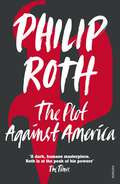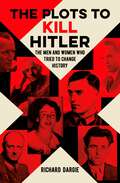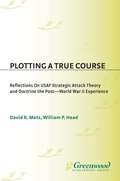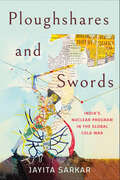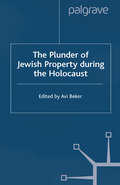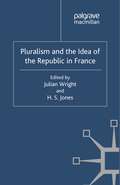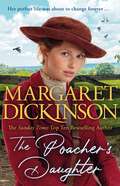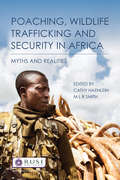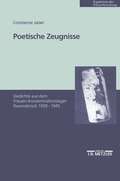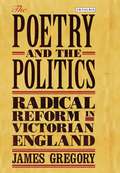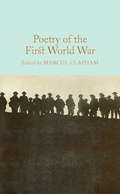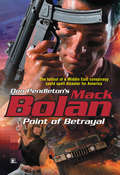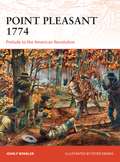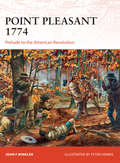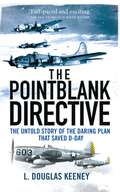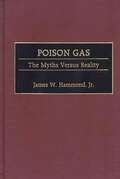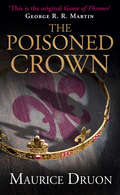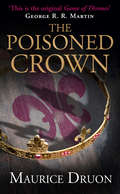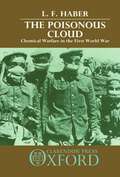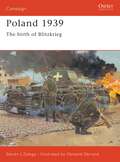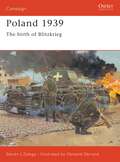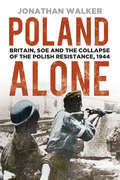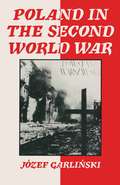- Table View
- List View
The Plot Against America: A Novel (Reading Group Guides)
by Philip Roth‘In The Plot Against America, Roth precisely described the sinister and chilling nightmare in which the United States now finds itself… America has not read enough of Philip Roth’ Bernard-Henri Lévy When the renowned aviation hero and rabid isolationist Charles A. Lindbergh defeats Franklin Roosevelt by a landslide in the 1940 presidential election, fear invades every Jewish household in America. Not only has Lindbergh publicly blamed the Jews for pushing America towards a pointless war with Nazi Germany, but, upon taking office as the 33rd president of the United States, he negotiates a cordial 'understanding' with Adolf Hitler, guaranteeing peaceful relations between the two nations. What then follows is the alternative America of this startling counterfactual novel by Philip Roth, who recounts what it was like for his Newark family during the menacingly anti-Semitic years of the Lindbergh presidency. Jewish families are shaken violently apart, whilst America is oblivious to its own dark metamorphosis.‘Many passages in The Plot Against America echo feelings voiced today by vulnerable Americans – immigrants and minorities as alarmed by Trump’s election as the Jews of Newark are frightened by Lindbergh’s’ New Yorker
The Plots to Kill Hitler: The Men and Women Who Tried to Change History
by Richard DargieFrom 1919 onwards, there were many people who wanted to kill Hitler. But when he became Chancellor of Germany in 1933, the desire became more urgent. After all, what do you do when the leader of your country has destroyed all political freedoms, annexed all power and is leading all of its people towards destruction? This is a story of all the plots against Hitler, of secret meetings in freezing fields, of bombs in briefcases, of conspiracies against the life of the Fuhrer, with a cast-list of soldiers, senior politicians, members of the resistance, schoolteachers, theologians, and even a humble carpenter. In all, there were more than 32 attempts against Adolf Hitler's life and this book documents every doomed effort to dismantle the Nazi machine by striking off its head.
Plotting a True Course: Reflections on USAF Strategic Attack Theory and Doctrine The Post World War II Experience (Non-ser.)
by William P. HeadExamining wars from the allied victory in World War II to the conflict in Viet Nam, and finally to the operations in the Gulf and Kosovo, this book presents a comprehensive look at the evolution of strategic air attack theory and doctrine over the years.
Ploughshares and Swords: India's Nuclear Program in the Global Cold War
by Jayita SarkarIndia's nuclear program is often misunderstood as an inward-looking endeavor of secretive technocrats. In Ploughshares and Swords, Jayita Sarkar challenges this received wisdom, narrating a global story of India's nuclear program during its first forty years. The book foregrounds the program's civilian and military features by probing its close relationship with the space program. Through nuclear and space technologies, India's leaders served the technopolitical aims of economic modernity and the geopolitical goals of deterring adversaries.The politically savvy, transnationally connected scientists and engineers who steered the program obtained technologies, materials, and information through a variety of state and nonstate actors from Europe and North America, including both superpowers. They thus maneuvered around Cold War politics and the choke points of the nonproliferation regime. Hyperdiversification increased choices for the leaders of the nuclear program but reduced democratic accountability at home. The nuclear program became a consensus-enforcing device in the name of the nation.Ploughshares and Swords is a provocative new history with global implications. It shows how geopolitical and technopolitical visions influence decisions about the nation after decolonization.Thanks to generous funding from the Swiss National Science Foundation, the ebook editions of this book are available as Open Access volumes from Cornell Open (cornellopen.org) and other repositories.
The Plunder of Jewish Property during the Holocaust: Confronting European History
by A. BekerMore than fifty years after the Holocaust, European and other countries are confronting newly-emerging memories and guilt-filled ghosts from the past. The campaign for the restitution of Jewish property stolen during the Holocaust touched a raw nerve within European society and, together with the end of the Cold War and generational change, created a need to re-evaluate conventional historical truths. A group of experts joined together to review in this book how the issue was dealt with in different countries and how national myths must be re-examined.
Pluralism and the Idea of the Republic in France
by Julian WrightThe idea of the centralized State has played a powerful role in shaping French republicanism. But for two hundred years, many have tried to find other ways of being French and Republican. These essays challenge the traditional account, bringing together new insights from leading scholars.
The Poacher's Daughter: The Heartwarming Page-turner From One of the UK's Favourite Saga Writers
by Margaret Dickinson‘I’m going to live in that house, Dad. One day I’ll be mistress of Thornsby Manor . . .’It is 1910 in the Lincolnshire Wolds. Young Rosie Waterhouse lives with her father, Sam, well known as the local poacher, in a cottage on the Thornsby estate. The land is owned by William Ramsey, a harsh and heartless man who is determined his only son, Byron, should marry well and produce an heir.Rosie is quick to learn the tricks of her father’s trade and it’s when she’s poaching fish from the estate’s stream that she meets Byron. They continue to meet in secret over the coming months and, as their friendship blossoms, they recognize that, despite their vastly different backgrounds, they are destined to be together. When William learns of their bond, he stops at nothing to ensure that they never meet again.As the years pass and the threat of war becomes a reality, Sam is involved in a tragic incident that will affect both his and Rosie’s lives more than they could ever have imagined. Life will never be the same in Thornsby, but will Rosie find the happiness she yearns for?
Poaching, Wildlife Trafficking and Security in Africa: Myths and Realities (Whitehall Papers)
by Cathy Haenlein M L SmithA worldwide surge in poaching and wildlife trafficking is threatening to decimate endangered species. This crisis also threatens the security of human beings in ways ignored until recently by decision-makers slow to begin to treat what is typically viewed as a ‘conservation issue’ as serious crime. Over the past decade, as the scale and profitability of poaching and wildlife trafficking have grown, politicians, journalists and campaigners throughout the world have begun to take notice – they are offering striking appraisals of the threat posed not only to endangered species but also to human populations. Many of these appraisals, however, are made in the absence of a detailed body of empirical research and analysis to underpin them. The result is the growth of a range of myths and misperceptions around the security threats posed, particularly as they relate to Africa. Poaching, Wildlife Trafficking and Security in Africa examines the most common narratives on poaching, wildlife trafficking and security. It critically analyses the dominant discourses on poaching and wildlife trafficking as threats to human security, as drivers of conflict, as funders of terrorism and as a focus for organised crime. In doing so, it seeks to sort myth from reality, to clarify how poaching and wildlife trafficking, as much cited threats to security, can most accurately be conceived. Such a study is crucial to the efforts of stakeholders now rightly looking to respond not just to the threat posed to endangered species, but also to the security and wellbeing of human beings.
Poaching, Wildlife Trafficking and Security in Africa: Myths and Realities (Whitehall Papers)
by Cathy Haenlein M L SmithA worldwide surge in poaching and wildlife trafficking is threatening to decimate endangered species. This crisis also threatens the security of human beings in ways ignored until recently by decision-makers slow to begin to treat what is typically viewed as a ‘conservation issue’ as serious crime. Over the past decade, as the scale and profitability of poaching and wildlife trafficking have grown, politicians, journalists and campaigners throughout the world have begun to take notice – they are offering striking appraisals of the threat posed not only to endangered species but also to human populations. Many of these appraisals, however, are made in the absence of a detailed body of empirical research and analysis to underpin them. The result is the growth of a range of myths and misperceptions around the security threats posed, particularly as they relate to Africa. Poaching, Wildlife Trafficking and Security in Africa examines the most common narratives on poaching, wildlife trafficking and security. It critically analyses the dominant discourses on poaching and wildlife trafficking as threats to human security, as drivers of conflict, as funders of terrorism and as a focus for organised crime. In doing so, it seeks to sort myth from reality, to clarify how poaching and wildlife trafficking, as much cited threats to security, can most accurately be conceived. Such a study is crucial to the efforts of stakeholders now rightly looking to respond not just to the threat posed to endangered species, but also to the security and wellbeing of human beings.
Poetische Zeugnisse: Gedichte aus dem Frauen-Konzentrationslager Ravensbrück 1939-1945 (Ergebnisse der Frauenforschung)
by Constanze JaiserDie Arbeit stellt einen Beitrag zur Erforschung der sogenannten Literatur des Holocaust dar. Die an Motiven wie an der poetischen Form ansetzende Untersuchung einer Vielzahl bislang unbekannter Gedichte kommt zu dem Ergebnis, dass die Texte nur in ihrer Einheit von Form und Inhalt und dabei vor allem in ihrem Zeugnischarakter verstanden werden können.
The Poetry and the Politics: Radical Reform in Victorian England (Library of Victorian Studies)
by Gregory James James GregoryThe nineteenth century was a time of 'movements' – political, social, moral reform causes – which drew on the energies of men and women across Britain. Radical reform at the margins of early Victorian society is studied by James Gregory in this book, focused on decades of particular social, political and technological ferment: when foreign and British promoters of extravagant technologically-assisted utopias could attract many hundreds of supporters of limited means, persuaded to escape grim conditions by emigration to South America; when pioneers of vegetarianism joined the ranks of the temperance movement; and when working-class Chartists, reviving a struggle for political reform, seemed to threaten the State for a brief moment in April 1848. Through the forgotten figure of James Elmslie Duncan, 'shabby genteel' poet and self-proclaimed 'Apostle of the Messiahdom,' The Politics and the Poetry considers themes including poetry's place in radical culture, the response of pantomime to the Chartist challenge to law and order, and associations between madness and revolution. Duncan became a promoter of the technological fantasies of John Adolphus Etzler, a poet of science who prophesied a future free from drudgery, through machinery powered by natural forces. Etzler dreamed of crystal palaces: Duncan's public freedom was to end dramatically in 1851 just as a real crystal palace opened to an astonished world.In addition to Duncan, James Gregory also introduces a cast of other poets, earnest reformers and agitators, such as William Thom the weaver poet of Inverury, whose metropolitan fêting would end in tragedy; John Goodwyn Barmby, bearded Pontiffarch of the Communist Church; a lunatic 'Invisible Poet' of Cremorne pleasure gardens; the hatter from Reading who challenged the 'feudal' restrictions of the Game Laws by tract, trespass and stuffed jay birds; and foreign exotics such as the German-born Conrad Stollmeyer, escaping the sinking of an experimental Naval Automaton in Margate to build a fortune as the Asphalt King of Trinidad. Combining these figures with the biography of a man whose literary career was eccentric and whose public antics were capitalised upon by critics of Chartist agitation, this book will be essential reading for anyone interested in radical reform and popular political movements in Victorian Britain.
Poetry of the First World War (Macmillan Collector's Library #141)
by Marcus ClaphamThe First World War was one of the deadliest conflicts in modern history and produced horrors undreamed of by the young men who cheerfully volunteered for a war that was supposed to be over by Christmas. Whether in the patriotic enthusiasm of Rupert Brooke, the disillusionment of Charles Hamilton Sorley, or the bitter denunciations of Siegfried Sassoon and Wilfred Owen, the war produced an astonishing outpouring of powerful poetry. Edited by author and editor Marcus Clapham, the major poets are all represented in this beautiful Macmillan Collector’s Library anthology, Poetry of the First World War, alongside many others whose voices are less well known, and their verse is accompanied by contemporary motifs.Designed to appeal to the booklover, the Macmillan Collector's Library is a series of beautiful gift editions of much loved classic titles. Macmillan Collector's Library are books to love and treasure.
Point Of Betrayal
by Don PendletonIMMEDIATE THREAT The former director of the CIA is assassinated in broad daylight on the streets of Pakistan, the opening act of a disaster show for America and the world. It's the kind of conspiracy that can only happen when madmen and conspirators get the money and power to play their hand with millions of innocent lives.
Point Pleasant 1774: Prelude to the American Revolution (Campaign)
by Peter Dennis John F. WinklerThe only major conflict of Lord Dunmore's War, the battle of Point Pleasant was fought between Virginian militia and American Indians from the Shawnee and Mingo tribes. Following increased tensions and a series of incidents between the American settlers and the natives, Dunmore, the last colonial governor of Virginia, and Colonel Andrew Lewis led two armies against the tribes. On October 10, 1774 Lewis and his men resisted a fierce attack, led by Shawnee chief Keigh-tugh-qua, or Cornstalk, at Point Pleasant, near the mouth of the Kanawha river. Despite significant losses on both sides, Lewis succeeded in forcing the Shawnee to retreat back to their settlements in the Scioto Valley. In the aftermath of the battle the Treaty of Camp Charlotte was signed in attempt to secure peace in the region and ultimately opened up Kentucky for American settlement. Illustrated with photographs, detailed maps and bird's-eye-views, this title brings to life one of the most significant pre-Revolutionary conflicts between American settlers and the native tribes.
Point Pleasant 1774: Prelude to the American Revolution (Campaign #273)
by Peter Dennis John F. WinklerThe only major conflict of Lord Dunmore's War, the battle of Point Pleasant was fought between Virginian militia and American Indians from the Shawnee and Mingo tribes. Following increased tensions and a series of incidents between the American settlers and the natives, Dunmore, the last colonial governor of Virginia, and Colonel Andrew Lewis led two armies against the tribes. On October 10, 1774 Lewis and his men resisted a fierce attack, led by Shawnee chief Keigh-tugh-qua, or Cornstalk, at Point Pleasant, near the mouth of the Kanawha river. Despite significant losses on both sides, Lewis succeeded in forcing the Shawnee to retreat back to their settlements in the Scioto Valley. In the aftermath of the battle the Treaty of Camp Charlotte was signed in attempt to secure peace in the region and ultimately opened up Kentucky for American settlement. Illustrated with photographs, detailed maps and bird's-eye-views, this title brings to life one of the most significant pre-Revolutionary conflicts between American settlers and the native tribes.
The Pointblank Directive: Three Generals and the Untold Story of the Daring Plan that Saved D-Day
by L. Douglas KeeneyWhere was the Luftwaffe on D-Day? Following decades of debate, 2010 saw a formerly classified history restored and in it was a new set of answers. Pointblank is the result of extensive new research that creates a richly textured portrait of perhaps the last untold story of D-Day: three uniquely talented men and why the German Air Force was unable to mount an effective combat against the invasion forces. Following a year of unremarkable bombing against German aircraft industries, General Henry H. "Hap†? Arnold, commander of the U.S. Army Air Forces, placed his lifelong friend General Carl A. "Tooey†? Spaatz in command of the strategic bombing forces in Europe, and his protégé, General James "Jimmy†? Doolittle, command of the Eighth Air Force in England. For these fellow aviation strategists, he had one set of orders – sweep the skies clean of the Luftwaffe by June 1944. Spaatz and Doolittle couldn't do that but they could clear the skies sufficiently to gain air superiority over the D-Day beaches. The plan was called Pointblank.
The Pointblank Directive: Three Generals and the Untold Story of the Daring Plan that Saved D-Day (General Military Ser.)
by L. Douglas KeeneyWhere was the Luftwaffe on D-Day? Following decades of debate, 2010 saw a formerly classified history restored and in it was a new set of answers. Pointblank is the result of extensive new research that creates a richly textured portrait of perhaps the last untold story of D-Day: three uniquely talented men and why the German Air Force was unable to mount an effective combat against the invasion forces. Following a year of unremarkable bombing against German aircraft industries, General Henry H. “Hap” Arnold, commander of the U.S. Army Air Forces, placed his lifelong friend General Carl A. “Tooey” Spaatz in command of the strategic bombing forces in Europe, and his protégé, General James “Jimmy” Doolittle, command of the Eighth Air Force in England. For these fellow aviation strategists, he had one set of orders – sweep the skies clean of the Luftwaffe by June 1944. Spaatz and Doolittle couldn't do that but they could clear the skies sufficiently to gain air superiority over the D-Day beaches. The plan was called Pointblank.
Poison Gas: The Myths Versus Reality (Contributions in Military Studies)
by James W. Jr.The threat of poison gas, and other related biological warfare agents, holds our society hostage to the possible actions of terrorist groups or rogue states. This study hopes to convince policymakers and the general public that the bad reputation that surrounds the use of gas is largely the result of propaganda, misinformation, and oft-repeated half-truths. With proper precautions and discipline, neither the military nor society need fear gas as a weapon of mass destruction, wielded by dictators and cowards who utilize the loopholes in international agreements and flaunt world opinion. While not advocating the use of toxic gas in warfare, the author argues that education and common sense are the most effective tools to combat the gases that remain in arsenals around the world.After a discussion of the earliest uses of gas and other similar tactics in warfare, this book explains how our image of gas has been shaped by early pronouncements that branded it a treacherous and barbarous weapon. The fear of retribution, as well as political motivations, prevented the use of gas warfare in the Second World War, but its use resurfaced in later decades both in warfare and in combatting internal strife. The author details various types of gas and discusses the most effective measures to counter each one. He also chronicles the long history of attempts to outlaw gas, why these attempts have failed, and why such efforts are not likely to succeed in the future.
The Poisoned Crown (The Accursed Kings #3)
by Maurice Druon“This is the original Game of Thrones.” George R.R. Martin.
The Poisoned Crown (The Accursed Kings #3)
by Maurice Druon“This is the original Game of Thrones.” George R.R. Martin.
The Poisonous Cloud: Chemical Warfare in the First World War
by L. F. HaberThe author examines fully the military role of chemical warfare and its effects on the people, industries, and administrations on both sides; he also considers the growing moral problems it created. The launching of an entirely new weapon that did not discriminate between soldiers and civilians raised complex issues which were debated endlessly between the wars and which, in recent years, have led to agreement among the powers not to use chemical or biological warfare.
Poland 1939: The birth of Blitzkrieg (Campaign)
by Steven J. ZalogaThe German invasion of Poland on 1 September 1939 began World War II in Europe, pitting the newly modernized army of Europe's great industrial power against the much smaller Polish army and introducing the world to a new style of warfare – Blitzkrieg. Panzer divisions spearheaded the German assault with Stuka dive-bombers prowling ahead spreading terror and mayhem. This book demonstrates how the Polish army was not as backward as it is often portrayed and fielded a tank force larger than that of the contemporary US Army. Its stubborn defence did give the Germans some surprises and German casualties were relatively heavy for such a short campaign.
Poland 1939: The birth of Blitzkrieg (Campaign)
by Steven J. ZalogaThe German invasion of Poland on 1 September 1939 began World War II in Europe, pitting the newly modernized army of Europe's great industrial power against the much smaller Polish army and introducing the world to a new style of warfare – Blitzkrieg. Panzer divisions spearheaded the German assault with Stuka dive-bombers prowling ahead spreading terror and mayhem. This book demonstrates how the Polish army was not as backward as it is often portrayed and fielded a tank force larger than that of the contemporary US Army. Its stubborn defence did give the Germans some surprises and German casualties were relatively heavy for such a short campaign.
Poland Alone: Britain, SOE and the Collapse of the Polish Resistance, 1944
by Jonathan WalkerPOLAND was the ‘tripwire’ that brought Britain into the Second World War, but neither Britain nor Poland’s older ally, France, had the military means to prevent Poland being overrun, and the broadcast, ‘Poland is no longer alone’ had a distinctly hollow ring. During the next five years the Polish Government-in-exile and armed forces made a significant contribution to the Allied war effort; in return the Polish Underground (Home Army) received only paltry quantities of supplies and men. Using veterans’ testimonies and previously classified material, Jonathan Walker examines the heroic attempts by elements of SOE and the RAF to aid the Poles, against a background of Allied inertia and calculating Soviet ambition. The war ended with over six million Poles dead, the crushing of their resistance movement and their culture, and the imposition of Soviet control. What more could Britain have done to help her loyal ally?
